Margaret B┤╬į¬╣┘═°═°ųĘ£MadgeB┤╬į¬╣┘═°═°ųĘØ Robertson Watt left her mark on early 20th century Victoria and now she has been honoured with a Parks Canada plaque commemorating her as a person of national historic significance.
The British Columbia WomenB┤╬į¬╣┘═°═°ųĘÖs Institute and the Metchosin Museum Society celebrated this monumental occasion with a ceremony inside council chambers at the Metchosin Municipal Hall recently after rain forced organizers to move proceedings indoors.
Metchosin Coun. Kyara Kahakauwila, Museum Society president Larry Tremblay and Ruth Shanks, president of the Associated Country Women of the World, were among the speakers during the ceremony.
WattB┤╬į¬╣┘═°═°ųĘÖs great niece Helen Geissinger also spoke, recalling some of the memories she has of her great aunt, who passed away in 1948.
 Geissinger told a packed room about her auntB┤╬į¬╣┘═°═°ųĘÖs determination, persistence and persuasiveness, skills she used throughout her remarkable life.
Geissinger told a packed room about her auntB┤╬į¬╣┘═°═°ųĘÖs determination, persistence and persuasiveness, skills she used throughout her remarkable life.
Watt, who was originally from Collingwood, Ont., graduated in 1890 from the University of Toronto with a Masters of Arts degree and was one of the first women to accomplish such a feat.
At 24, she was named editor of the Ladies Pictorial Weekly and in 1893 she moved to Victoria following her marriage to Alfred T. Watt.
In 1897, AlfredB┤╬į¬╣┘═°═°ųĘÖs work as a doctor took the couple to the Quarantine Station at William Head, where they lived for the next 16 years. During her time in Metchosin, Madge became a charter member of the Metchosin WomenB┤╬į¬╣┘═°═°ųĘÖs Institute.
After her husbandB┤╬į¬╣┘═°═°ųĘÖs death in 1913, Madge moved to London with her children and helped introduce the concept of WomenB┤╬į¬╣┘═°═°ųĘÖs Institutes to British women.
She later helped establish the Associated Country Women of the World and was elected the organizationB┤╬į¬╣┘═°═°ųĘÖs first president.
Today, Associated Country Women of the World has nine million members in 70 countries. WattB┤╬į¬╣┘═°═°ųĘÖs plaque is located on the Metchosin Municipal Grounds.
joel.tansey@goldstreamgazette.com



